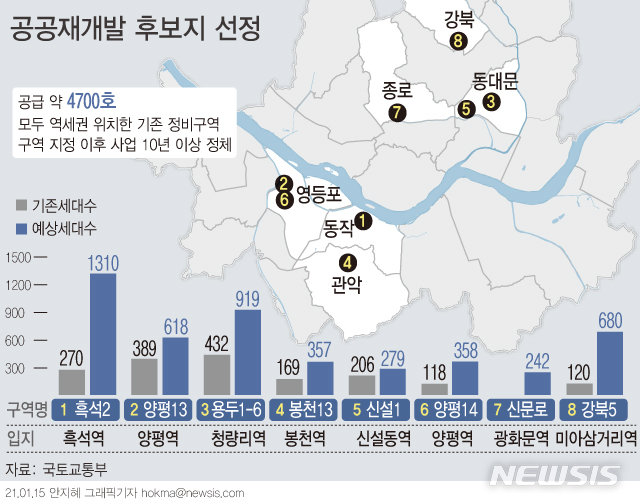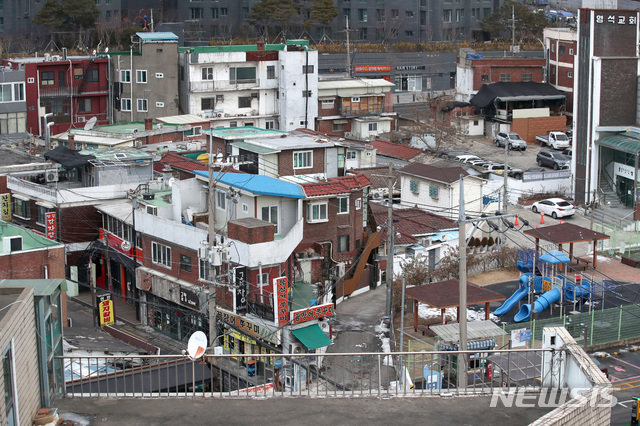–
The government announced the results of the selection of candidate sites for public redevelopment on the 15th, providing an opportunity for the city maintenance project, which had been stagnant after the release of New Town in 2012, to resume. However, it is difficult to increase profitability as public projects such as Korea Land and Housing Corporation (LH) and Seoul Housing and Urban Corporation (SH) are leading the project, and residents are highly reluctant to lease the amount, so it is difficult to view the project only optimistically.
In fact, the eight public redevelopment candidates announced by the government on that day were all in the station area, but there was no clear progress for more than 10 years after the start of the project due to conflicting interests among residents, such as a mixture of residential and commercial areas.
●Land owners keen on the amount of lease
 -The government decided to increase the floor area ratio (the sum of the land area versus the building floor area) applied to these areas to 1.2 times the legal upper limit, and give incentives to exclude it from the pre-sale price limit. For example, a floor area ratio of 300% will be applied to the Dongdaemun New 1 Redevelopment Project (11,204㎡). This is 1.2 times the upper limit of the floor area ratio (250%) for class 2 general residential areas. The existing 169 households will increase to 279 households. Instead, half of the remaining volume, excluding the member volume, must be supplied by rental. If the number of households minus the member’s share is 100, 50 households should be turned into public lease and public support lease. 20-50% of the floor area ratio, which is higher than the legal limit, must be donated to build public leases. The contributions due to the increase in the floor area ratio are included in the amount of public rental. On the contrary, in the case of Seoul, only 15% of the total volume of redevelopment needs to be supplied as public lease, which is lower than that of public redevelopment. Instead, the floor area ratio cannot be raised beyond the legal upper limit, and if the floor area ratio is raised over the existing plan, 50-75% of the increased floor area ratio must be donated. In other words, public redevelopment is advantageous in terms of profit structure in terms of floor area ratio and donations, whereas general redevelopment is advantageous in terms of rental volume. Residents in some redevelopment zones withdrew their applications due to the fact that rental housing is increasing. There is a reaction that even on-site cooperatives cannot determine whether to proceed until they receive specific results of the feasibility analysis. An official from the Gangbuk District 5 Redevelopment Promotion Committee said, “It is not clear how the public will intervene and do business with the union as well as the business conditions such as the proportion of rental housing and residents’ contributions.”
-The government decided to increase the floor area ratio (the sum of the land area versus the building floor area) applied to these areas to 1.2 times the legal upper limit, and give incentives to exclude it from the pre-sale price limit. For example, a floor area ratio of 300% will be applied to the Dongdaemun New 1 Redevelopment Project (11,204㎡). This is 1.2 times the upper limit of the floor area ratio (250%) for class 2 general residential areas. The existing 169 households will increase to 279 households. Instead, half of the remaining volume, excluding the member volume, must be supplied by rental. If the number of households minus the member’s share is 100, 50 households should be turned into public lease and public support lease. 20-50% of the floor area ratio, which is higher than the legal limit, must be donated to build public leases. The contributions due to the increase in the floor area ratio are included in the amount of public rental. On the contrary, in the case of Seoul, only 15% of the total volume of redevelopment needs to be supplied as public lease, which is lower than that of public redevelopment. Instead, the floor area ratio cannot be raised beyond the legal upper limit, and if the floor area ratio is raised over the existing plan, 50-75% of the increased floor area ratio must be donated. In other words, public redevelopment is advantageous in terms of profit structure in terms of floor area ratio and donations, whereas general redevelopment is advantageous in terms of rental volume. Residents in some redevelopment zones withdrew their applications due to the fact that rental housing is increasing. There is a reaction that even on-site cooperatives cannot determine whether to proceed until they receive specific results of the feasibility analysis. An official from the Gangbuk District 5 Redevelopment Promotion Committee said, “It is not clear how the public will intervene and do business with the union as well as the business conditions such as the proportion of rental housing and residents’ contributions.”
Young-jin Ham, head of Jikbang Data Lab, said, “The proportion of rental housing and supply method are issues that residents respond sensitively, but the process of obtaining resident consent will not be easy.” “The public maintenance of small and medium-sized projects that relatively easy to obtain resident consent It is highly likely to be promoted as a business.”
● We are already concerned about whether we will become speculators
 –
–When the candidate site for the public redevelopment pilot project was announced, a call for purchase inquiries continued for a while to the real estate near Heukseok 2 redevelopment area in Dongjak-gu, Seoul. Voices of concern about speculation have already emerged. In fact, in Real Estate A near Heukseok District 2, another man was waiting for his turn in addition to a customer consulting with a realtor. An official at the brokerage firm said, “After the government announcement, telephone inquiries have been continuously received and three teams have been booked for visits related to zone 2,” he said. A nearby B real estate official also said, “More than 10 calls have been received since the government announced in the morning. Inquiries are continuing through blogs and YouTube,” he said. “There have been few inquiries so far, but the atmosphere has changed.” Kim Mo (79), who lives in Dongjak-gu, expressed anticipation, saying, “If District 2 is developed in the future, it will be a good neighborhood to live in.”
The government plans to start setting up a maintenance plan from June after going through a resident briefing between February and March, and to finish designating maintenance zones and implementers by the end of this year. Deok-rye Kim, a senior research fellow at the Housing Industry Research Institute, said, “It is a different issue between becoming an implementer of the public and securing publicity instead of providing public support. It needs to be presented.”
Reporter Lee Sae-sam [email protected]Go to reporter page>
Reporter Kim Ho-kyung [email protected]
Reporter Jeong Soon-gu [email protected]
Copyright by dongA.com All rights reserved.
—
–


